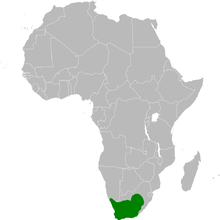Large-billed lark
| Large-billed lark | |
|---|---|
 | |
| Nominate race at De Hoop Nature Reserve, South Africa | |
| Scientific classification | |
| Kingdom: | Animalia |
| Phylum: | Chordata |
| Class: | Aves |
| Order: | Passeriformes |
| Family: | Alaudidae |
| Genus: | Galerida |
| Species: | G. magnirostris |
| Binomial name | |
| Galerida magnirostris (Stephens, 1826) | |
| Subspecies | |
|
see text | |
 | |
| resident range[2] | |
| Synonyms | |
| |
The large-billed lark or southern thick-billed lark (Galerida magnirostris) is a small passerine bird found in southern Africa. The name "large-billed lark" may also refer to Bradfield's lark. The name "thick-billed lark" more commonly refers to the species of the same name (i.e. Rhamphocoris clotbey).
Taxonomy and systematics
The large-billed lark was originally placed in the genus Alauda, and then Calendula until that genus was subsequently re-named to the present Galerida.[3] Another alternate name used for the large-billed lark is the long-billed lark.[4]
Subspecies
Three subspecies are recognized:[5]
- G. m. magnirostris (Stephens, 1826): Found in south-western South Africa
- G. m. sedentaria Clancey, 1993: Found in south-western Namibia and western South Africa
- Orange Free State large-billed lark, G. m. harei (Roberts, 1924): Found in central South Africa, Lesotho
Description
The large-billed lark is 18 cm in length. It is relatively short-tailed and has a thick bill with a yellow base to the lower mandible. It has streaked brown-grey upperparts, and a long white supercilium. Like other species in the genus, it has a crest that can be raised in display or alarm. The underparts are cream-coloured with heavy dark streaking on the breast. The heavy bi-coloured bill distinguishes this species from all other African larks.
The call of this very vocal species is a soft creaking "treeeeleeeeleee".
Distribution and habitat
The large-billed lark is a resident breeder in southern South Africa, Lesotho and southernmost Namibia. Its natural habitat is fynbos, karoo scrub and mountain grassland. The large-billed lark is also found in cultivated and fallow agricultural land.
Behaviour and ecology
Like other larks, the large-billed lark nests on the ground. Its food is seeds and insects, the latter especially in the breeding season.
References
- ↑ BirdLife International (2012). "Galerida magnirostris". IUCN Red List of Threatened Species. Version 2013.2. International Union for Conservation of Nature. Retrieved 26 November 2013.
- ↑ Based on maps in the Handbook of the Birds of the World and the BirdLife data zone
- ↑ "Galerida magnirostris - Avibase". avibase.bsc-eoc.org. Retrieved 2016-12-06.
- ↑ "Galerida magnirostris - Avibase". avibase.bsc-eoc.org. Retrieved 2016-12-10.
- ↑ "IOC World Bird List 6.4". IOC World Bird List Datasets. doi:10.14344/ioc.ml.6.4.
- Sinclair, Hockey and Tarboton, SASOL Birds of Southern Africa, ISBN 1-86872-721-1
- BirdLife International
External links
- Species text - The Atlas of Southern African Birds
